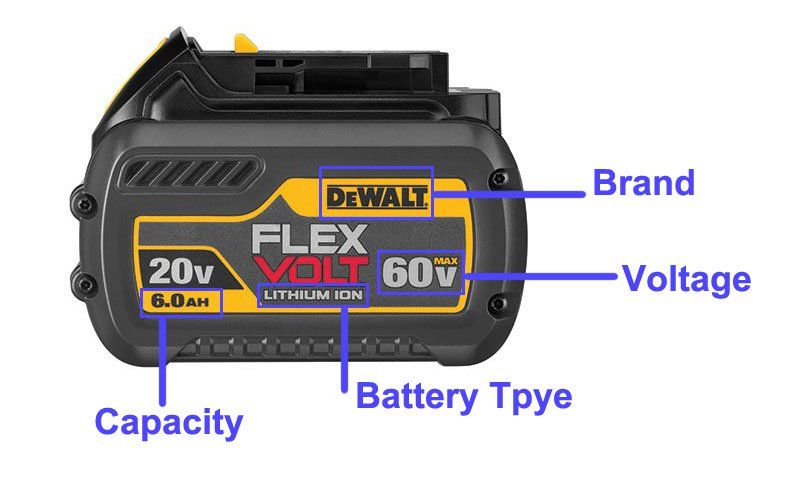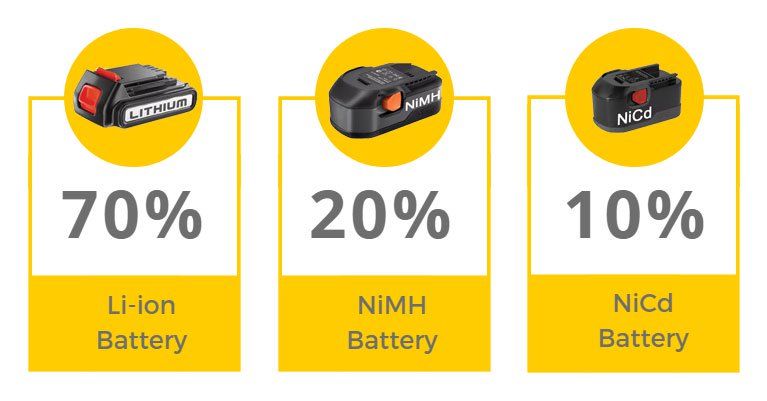
- Dewalt Cordless Drill Battery
- Makita Power Tool Batteries
- Bosch Crodelss Drill Batteries
- Milwaukee Tool Batteries
- Craftsman Power Tool Battery
- Black & Decker Drill Batteries
- Ryobi Cordless Drill Batteries
- Paslode Cordless Drill Battery
- Dyson Vacuum Cleaner Battery
- Irobot Vacuum Batteries
- Worx Cordless Drill Batteries
- Dremel Cordless Tool Batteries
- Panasonic Power Tool Battery
- Hitachi Power Tool Battery
- AEG Cordless Drill Batteries
- Metabo Power Tool Batteries
- Firestorm Cordless Drill Battery

Drill Battery Store > Tool Battery Blogs > Guide to Choosing Best Drill Batteries
Guide to Choosing Best Drill Batteries for Your Cordless Tools

The world of power tool batteries has been going through major technological advancements. Currently, many homeowners, craftsmen, and businesses have more options when it comes to selecting the best battery for their cordless power tool. They can already determine what works well for them in terms of capacity, compatibility, longer runtimes and extended cycle life of their batteries.
Ideal power tool batteries function better when well-aligned to the machine and the user. Components and features include as the perfect amount of battery capacity, charge time and temperature tolerance. So, the result is that many brands are working around the clock to meet the needs of all users.
The cycle of a battery is determined by the number full charge and discharge cycles. This is before its functional capacity falls to below 80% of its original capacity. A battery's life cycle takes into consideration the number of charges and discharges before it becomes obsolete.
There are many factors that determine the number of cycles that a Milwaukee battery undergoes before it makes its final bow; these include the discharge rate and depth of discharge. The battery's operating temperature and charging methods are also key considerations.
When it comes to cycle life, users consider it with other accompanying and supportive features such as runtime. A case in point is where users would go for Li-ion irrespective of its shorter cycle life, but it is then not an issue especially if you want to keep your power tool operating for a longer time.
Self-discharge occurs when the electrical capacity of the battery is lost, mostly because the cell is sitting on the shelf and not active at all. Electrical and internal chemical reactions within the cell are what initiates self-discharge, in what looks like the exertion of a small external load. This automatically reduces the stored charge of the battery.
Self- discharge is one key reason for the decrease in the shelf life of a battery. When in use, the battery tends to function at less than full charge simply because of self-discharge.
The truth is that self-discharge does not pose huge problems at all, especially if your power tool does not require storage. But for those using their power tool occasionally, they may want to purchase Craftsman tool batteries that have a slower self-discharge. This is because their tools and battery will have to be inactive during some periods.
Also known as lazy battery effect, memory effect occurs when there's a reduction in the durability of a battery's charge. This is a consequence of repeated recharging after incomplete discharge in earlier usages. The frequent recharging in effect causes the crystalline structure of the electrodes to manifest differently.
The capacity of the charging system is also gradually reduced. In this case, the battery tries to remember and function on the small capacity. There are several causes of memory effect/ these include:
- Repeated partial charges
- The make of the battery; there are some models that develop memory effect in cases of incomplete discharge before recharging.
- High or low rates of discharge
- When the charging time is limited and inadequate
- The charger is itself is poorly designed or malfunctioning
Memory effect reduces the capacity of the battery in later and subsequent recharges. At the same time, the battery life is also reduced.
Different designs and models react differently to the memory effect. Some of them do not experience memory effect at all, while others undergo significant levels of the same.
However, if you are looking for power tool batteries for your cordless tool, you shouldn't let the issue of memory effect scare you. Some batteries react just as well to the situation especially if you know what buttons to press. For instance, the nickels are quite vulnerable to memory effect, yet they tend to retain the capacities once they are charged. The charging is best done once they have dropped to less than 70 %. Another trick is to allow them to discharge deeply once in a while; this helps them to remember their initial true capacities.
Basically, Voltage in a battery signifies the difference in electric potential between the positive and negative terminals of a battery. One terminal is positively charged, and the other is negatively charged. If there is a big difference in the potential, it leads to a greater voltage. In essence, voltage is what determines the amount of energy a battery can discharge at one single time.
Charging a battery makes the voltage rise while discharging makes the voltage to fall low. It is like stretching and releasing a rubber band. There is an increase in both temperature and pressure during charge, hence increasing the voltage. Over-exertion and uncontrolled increase of the same can easily lead to rupture and explosion of the battery. In the same way, discharging the battery below the recommended capacity's lower voltage can also lead to permanent damage to the battery.
The range in voltage is reflected in the size of each battery. The range also depends on the material the battery has been created from. In the case of the power tools, the higher the voltage, the heavier the work it can possibly handle.
Generally speaking, the choice of voltage depends largely on work density. For instance, batteries that come in lesser voltage handle lighter work. The amount of voltage for that kind of work is 7V-15V, while heavy work translates into more than 18V.
Battery capacity is determined and measured in ampere-hours. As such, Ah is the discharge current that a battery delivers over a period of time. It is possible to install with a higher Ah, than specified, to allow for longer runtime; at the same time, using a smaller pack than specified, allows for shorter runtime.
As is expected, chargers often have some tolerance when it comes to Ah. This then allows larger batteries to take a longer time to charge, as compared to a smaller pack.
As you look to purchase Black and Decker drill batteries for your cordless power tools, it helps to know their Ah. For instance, when the Ah is higher, the runtime is longer, and battery use also takes longer before you recharge.
Batteries are essential, as, without them, devices and tools become useless. When it comes to using power tools, there are so many options in terms of specifications, performance and even features. Your selection is based on what kind of features suit your power tool the best, but also on the amount of work output you would like to achieve.

Comparison of Power Tool Battery Types
- Cycle life: the cycle life for NiCd is more than 1000 charges; NiMH's depends on correct storage and charging. Li-ion's cycle life is short; presenting between 300-500 charges. This is equivalent to 2-3 years of use.
- Self -discharge: NiCd experience moderate self-discharge of between 15-20%.On the other hand, NiMH has fast self-discharge of 20-30%. Li-ion displays very slow self-discharge and sometimes none at all.
- Charge time: Charge time for the Nickels is quite fast, while Li-ion charge time is moderate.
- Capacity: NiCd comes with a low capacity of 1.2-2.2Ah.the capacity for NiMH is moderate with 2.3-3.0Ah.As for Li-ion, its capacity is high at 3.0Ah.
- Memory effect: If not well maintained, the memory effect for NiCd is usually high, while it's moderate for NiMH, although this can be avoided with proper charging. Li-ion does not display experience memory effect.
- Sensitivity: NiCd is tough and not sensitive, while NiMH is highly sensitive to temperature. Li-ion is also quite sensitive to both heat and impact.



Product names, logos, brands and other trademarks are the property of their respective trademark holders in the United States and other countries.
Copyright © 2010-2025 At www.drill-battery.com. All Rights Reserved.
